Picking and pickling grape leaves is easier than you might think. Once you learn how to preserve grape leaves at home, you can use them to make my delicious Instant pot grape leaf dolma! I'll show you how to pick and pickle grape leaves using two easy methods.
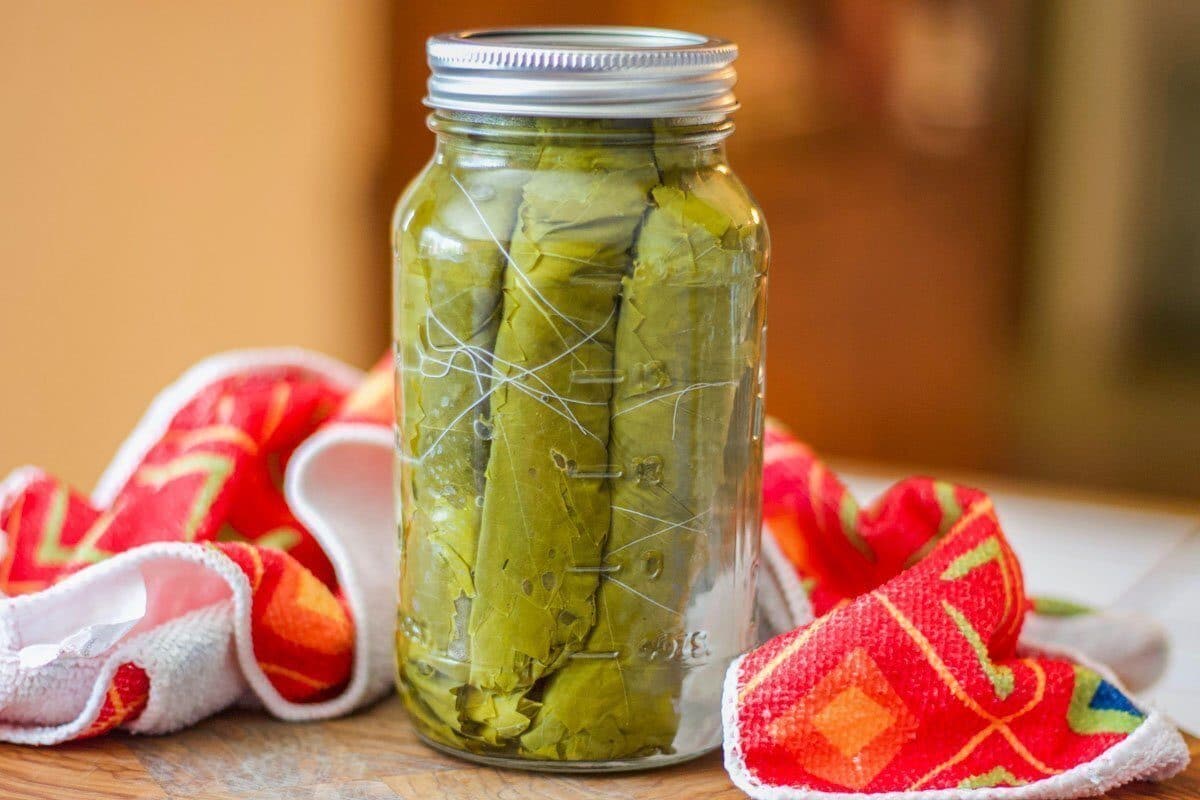
Once you pickle your own grape leaves, you'll never have to worry about where to buy jarred leaves again! Use them to make both Middle Eastern dolma and dolmadakia.
Jump to:
😍 Why You'll Love This Recipe
- For starters, unlike store-bought grape leaves, which are too large and too tough, homemade pickled grape leaves are a perfect size and they melt in your mouth.
- You'll also save money making your own preserved grape leaves and take advantage of what's growing in your own backyard, or your neighbors. 😉
- Preserved grape leaves have a long shelf life, so you can have them on hand whenever you crave some dolma.
🔖 Ingredients & Substitutions
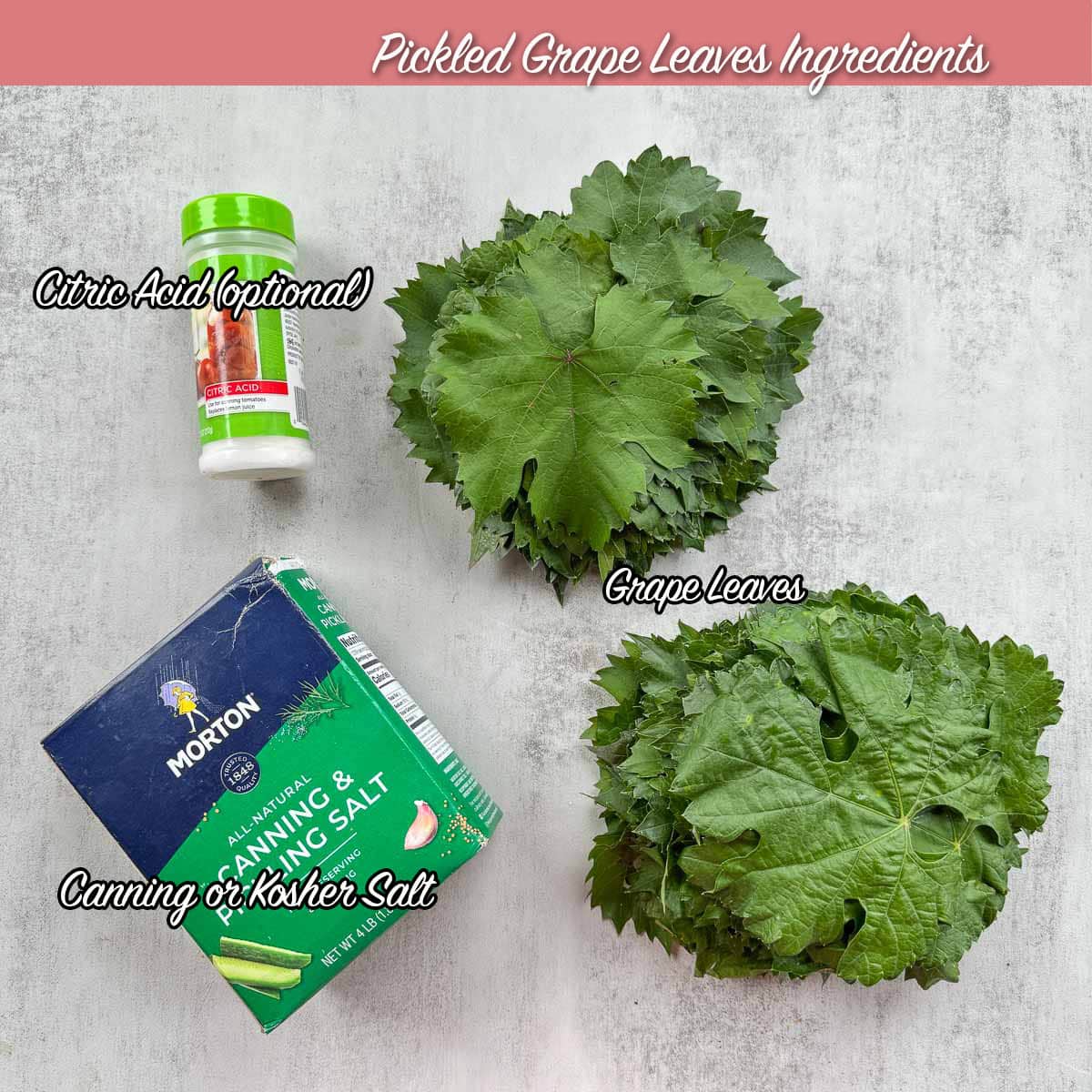
- Grape Leaves: Pick fresh, young grape leaves that are about the size of your palm.
- Salt & Citric Acid: The salt and citric acid are needed to preserve the grape leaves.
👌 How to Pick Grape Leaves
Making unforgettable dolma starts with using the perfect grape leaves! I recently had someone tell me that they didn't like grape leaf dolma. When I asked her why, she said she didn't like the tough texture of the leaves.
I explained to her that dolma should melt in her mouth. It shouldn't even require chewing! So, what is the secret to melt-in-your-mouth dolma? The grape leaves you use!!!
For starters, the grape leaves used should not come out of a jar, not a store-bought jar, anyway. Store-bought grape leaves are too large, tough, and stringy. I've been told that the Orlando brand is the best. I tried them and was disappointed. What can I say, I've been spoiled with fresh grape leaves all my life!
However, there is an art to picking grape leaves. The shape, size, and age of the leaves matter greatly. Not all grape leaves are appropriate for dolma. Some are too old, too tough, or just the wrong shape.
Others are too small or have insect damage. Let's go over some pointers on picking the perfect grape leaves for making Dolma.
Age of the Leaves
When picking grape leaves, you want thin, tender leaves that are lighter in color. When you feel the leaf, it should be thin and not leathery. It should be delicate enough to tear easily.
If a leaf feels dry or leathery, or is yellowing around the edges and has "rust spots," it's most likely past its picking prime.
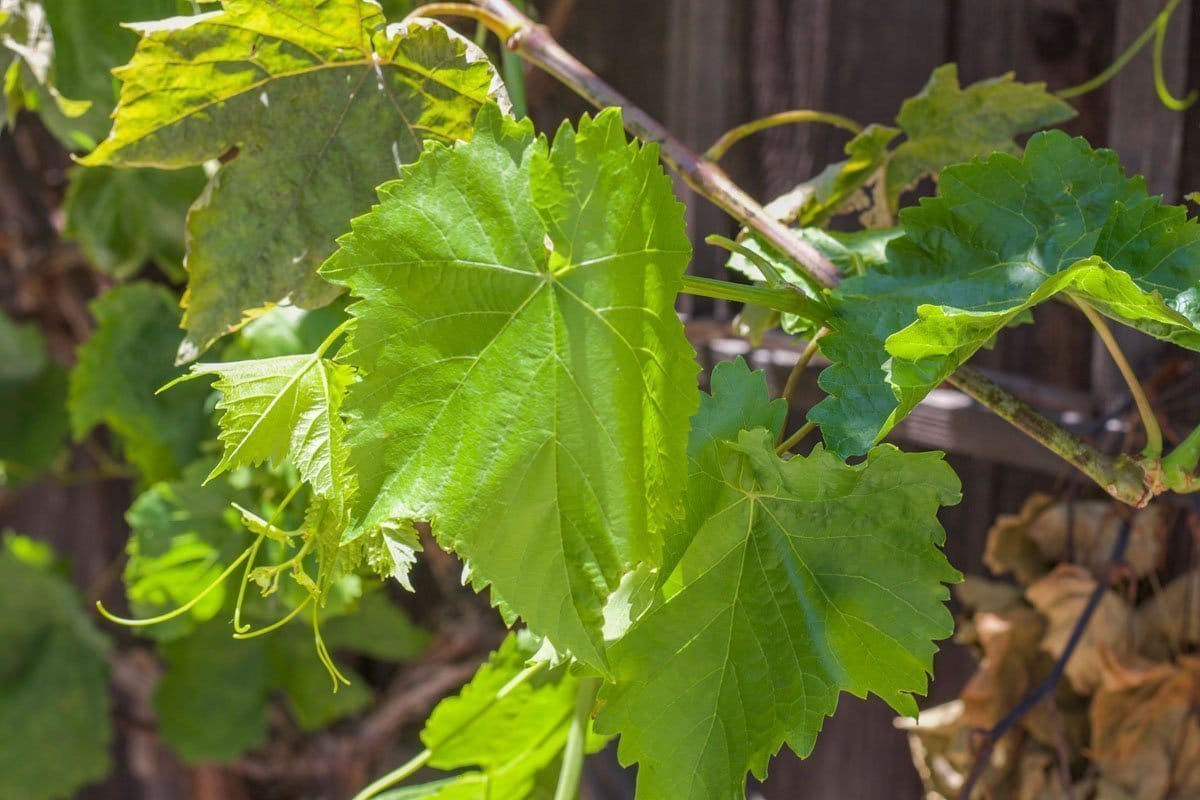

The Leaf Shape
Another thing you want to pay attention to is the leaf shape. Some grape varieties have a deep split in the leaves. This particular shape does not allow you ample space to add the filling. As a result, they will be more difficult to stuff.
Of course, if it's the only vine you have access to, you can still use it. It's just not the ideal shape for making dolma.
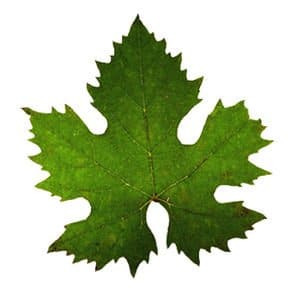
Other varieties have less of a split, which is ideal. Luckily, the grapevine I have in my yard has perfectly shaped leaves (see below).
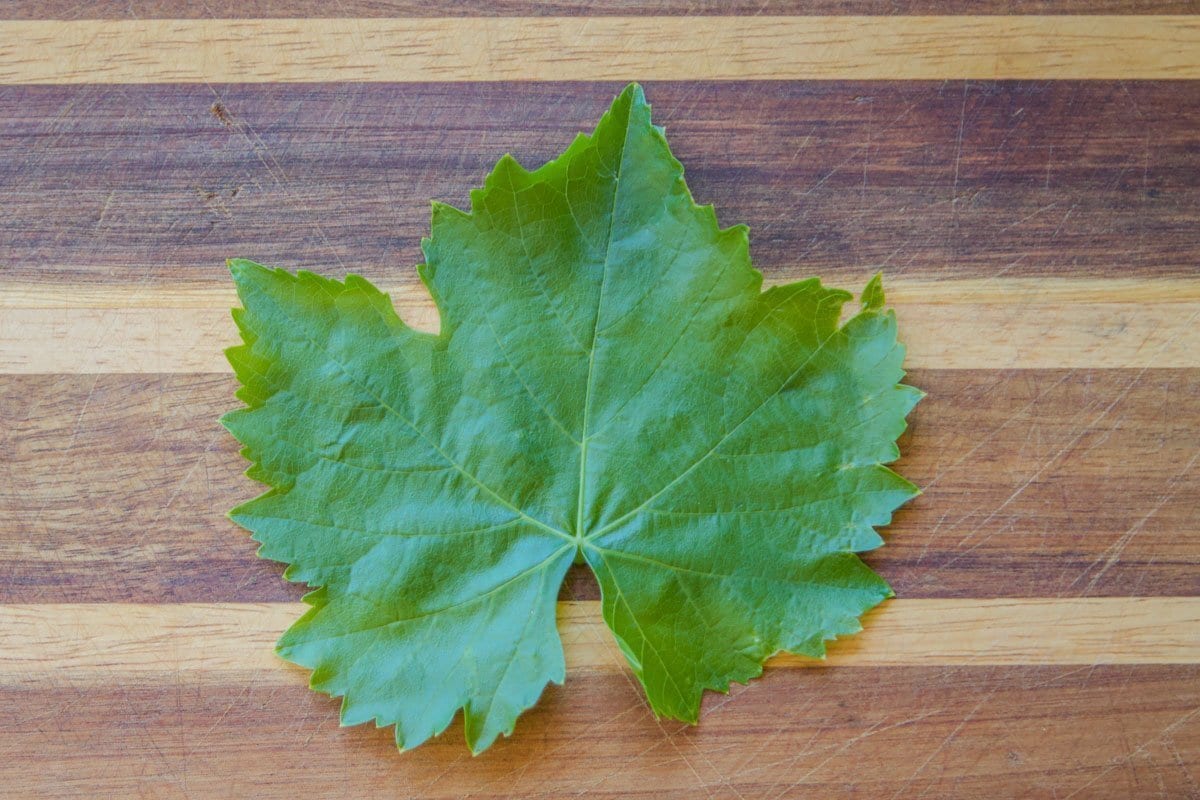
Leaf Size
This is one case where the size matters. If the grape leaf is too big, the dolma rolls will be too big as a result. Let me just say, Mom would never have approved! Not to mention, the leaves will be too tough.
The larger leaves, however, are perfect for layering on the bottom of the pot to keep the dolma from getting scorched. The ideal leaf should be approximately six inches.
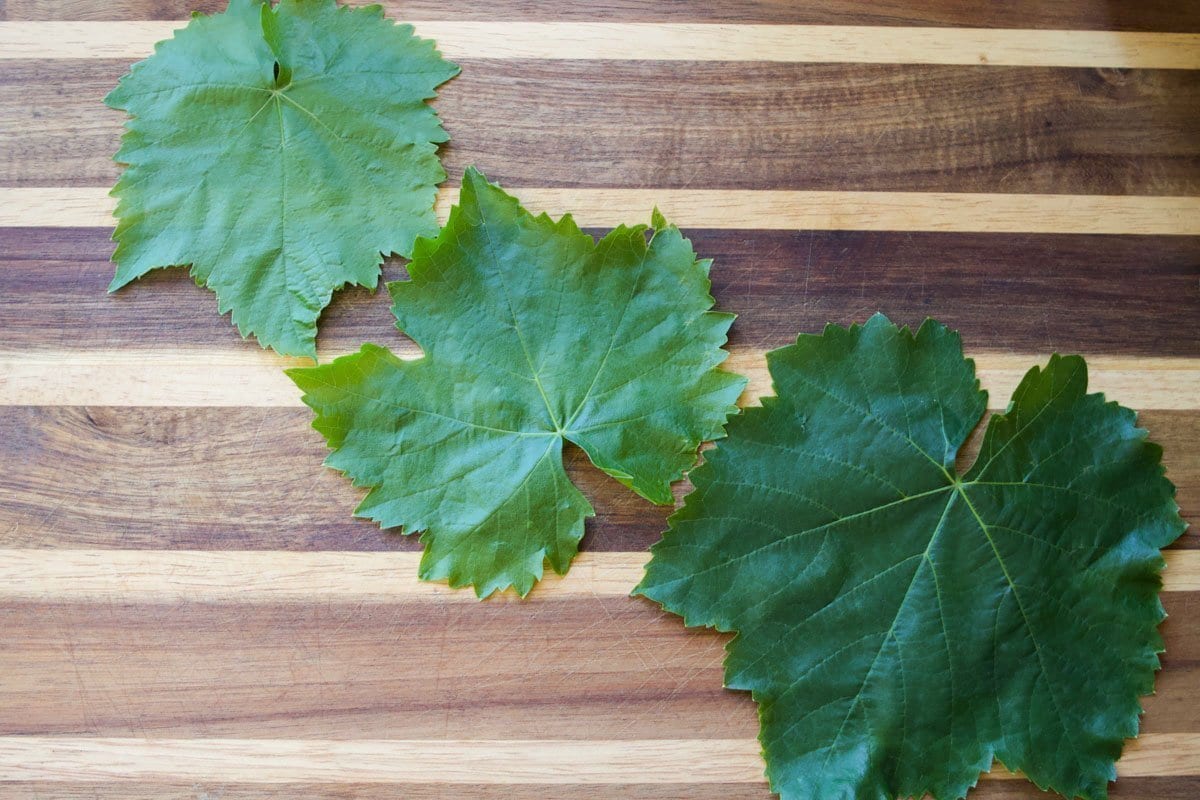
The Stem
This one is a personal pet peeve of mine. When you pick the leaves, please don't be like my sister, Beni. She picks them with a couple of inches of stem still attached.
When you do this, you're making more work for yourself. You will have to cut the stems again (but closer to the leaves) before using them. Why do this twice? (Sorry, sis, I still love you!)
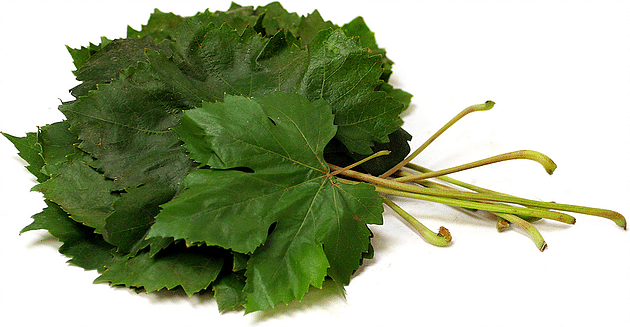
Beware of Insects
Another thing to keep an eye out for is little critters that like to hang out on the back of the leaves. Some are very tiny, so if your eyesight is not what it used to be (me🧐), make sure you have your glasses on. You will need them to see the tiny eggs and other small insects that are commonly found partying behind the leaves.
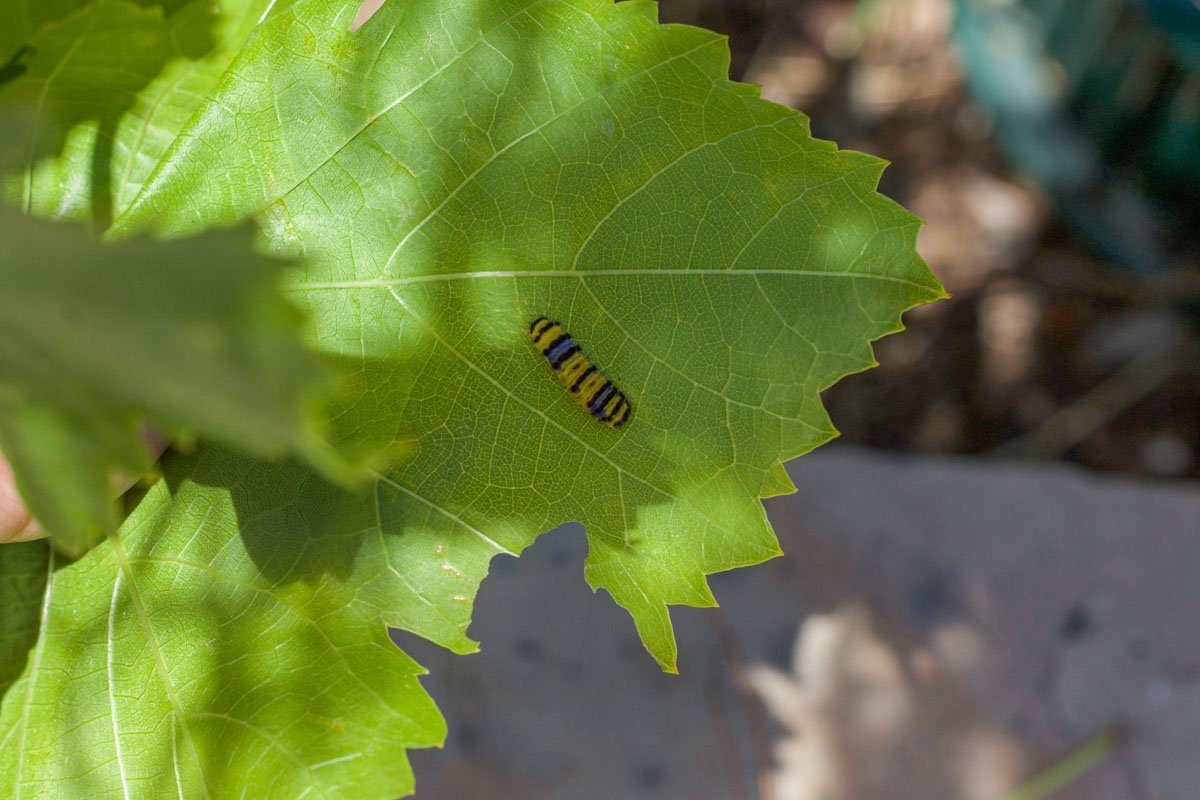

🍇 How to Pickle Grape Leaves in Water
Step 1: Wash grape leaves thoroughly, paying special attention to the back of the leaves, where insects lay their eggs.
Would you like to save this recipe?

Step 2: Divide the leaves into piles of ten, making sure all the leaves are facing the same direction. This will make things easier when it comes time to stuff them.
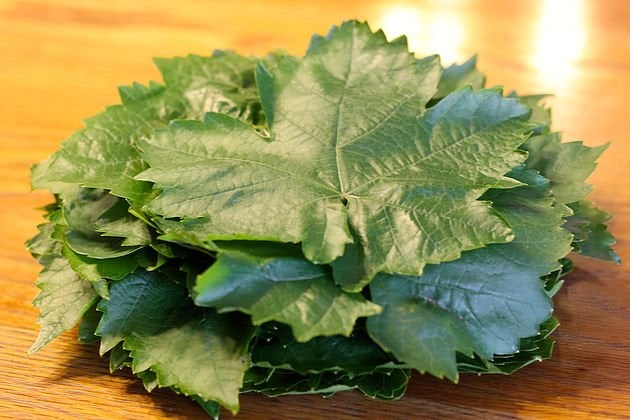
Step 3: Bring 8 cups of water to a boil, then simmer on low. Using tongs, gently place one pile of leaves in the water for 30 seconds, then carefully flip the entire pile and immerse for an additional 30 seconds.
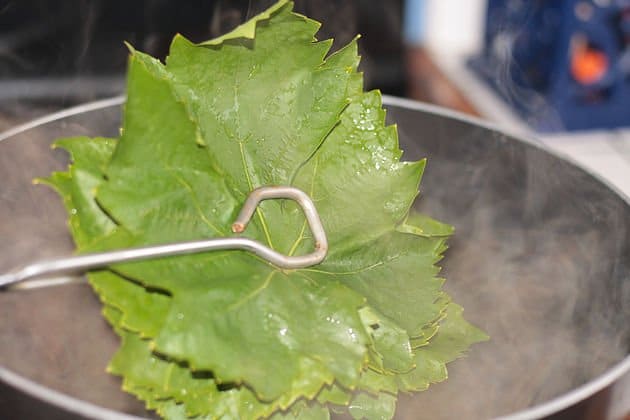
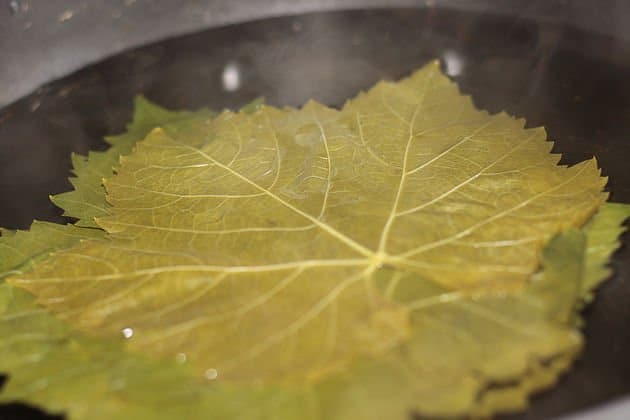
Pro Tip: Depending on the leaves you are using, sometimes it takes a little longer for them to become pliable. The best way to tell when they're ready is when the color changes from bright green to a dull, olive color.
Step 4: After blanching the leaves, drape them over the side of a bowl. Continue with the remaining piles. Once the water has drained out of the leaves, roll each pile into a cigar-shaped roll.

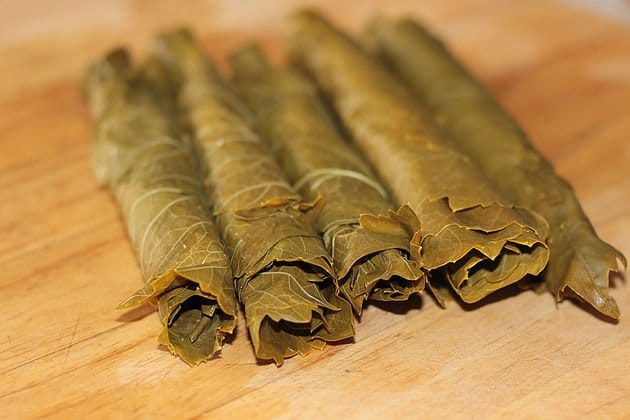
Step 5: Tie each pile of grape leaves with a string. This will help keep them from unrolling when you place them in the jar.
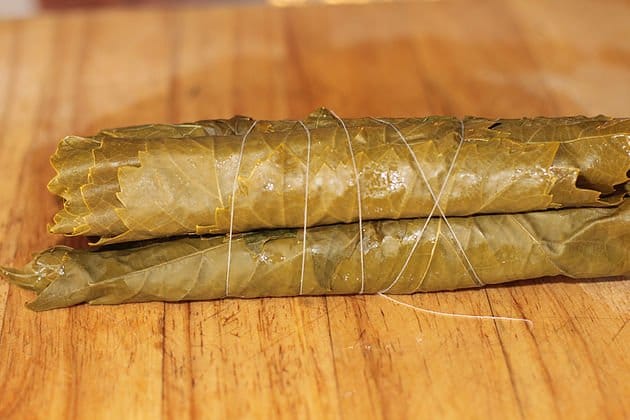
Step 6: Boil three cups of water and stir in the salt and citric acid until completely dissolved. Stand the rolled leaves in a sterilized jar and pour the salted water over them, leaving ¼" headspace. Tighten the lid and process in boiling water for 10 minutes.

🧂How to Preserve Grape Leaves Using Salt
There is another method of preserving the leaves that's even easier and my new favorite way of preserving grape leaves! Here's how to do it!
Step 1: Wash grape leaves and sort into piles. Make a pile of the leaves that are too large, which will be used to line the bottom of the pot.
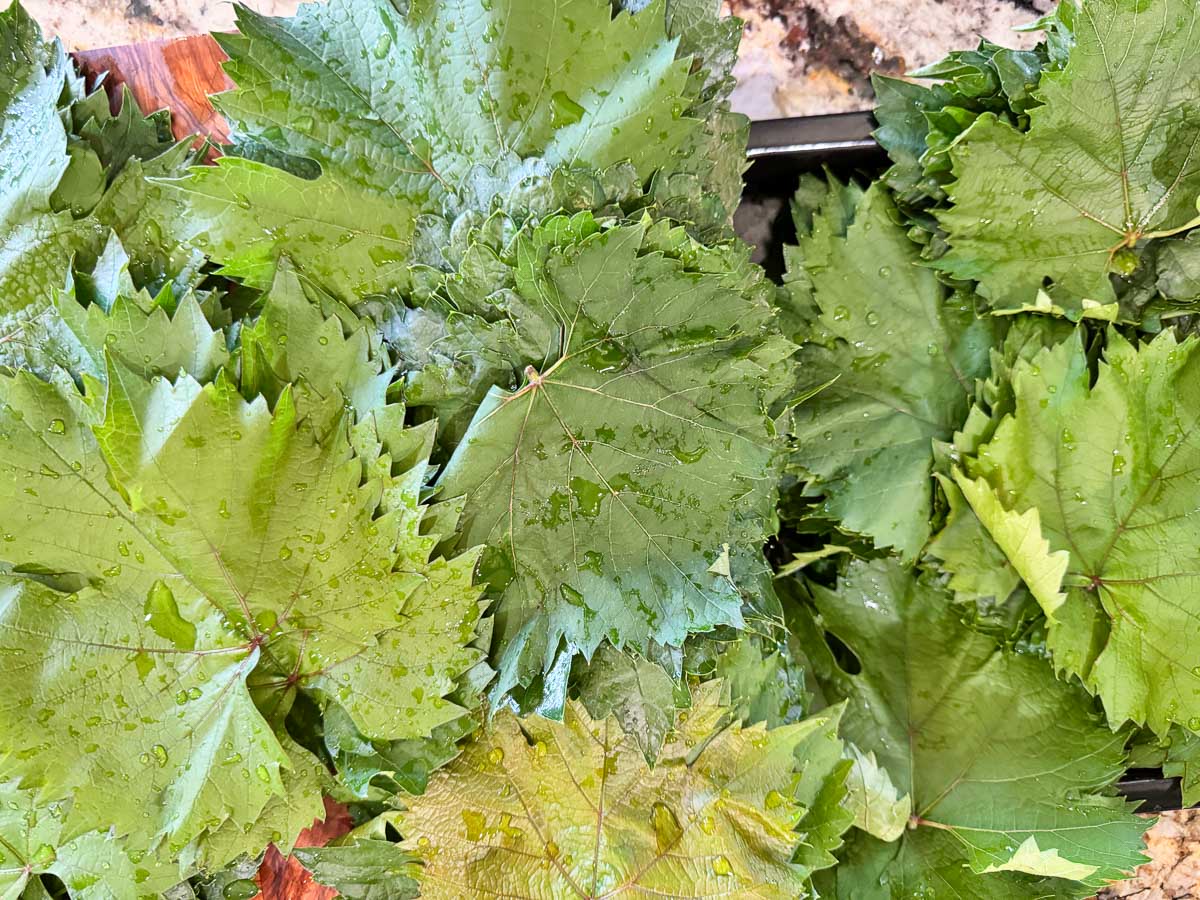
Step 2: Make piles with remaining leaves (10 per pile) then sprinkle either kosher salt of pickling salt between the leaves. Roll each pile tightly and tie it with string or twine.
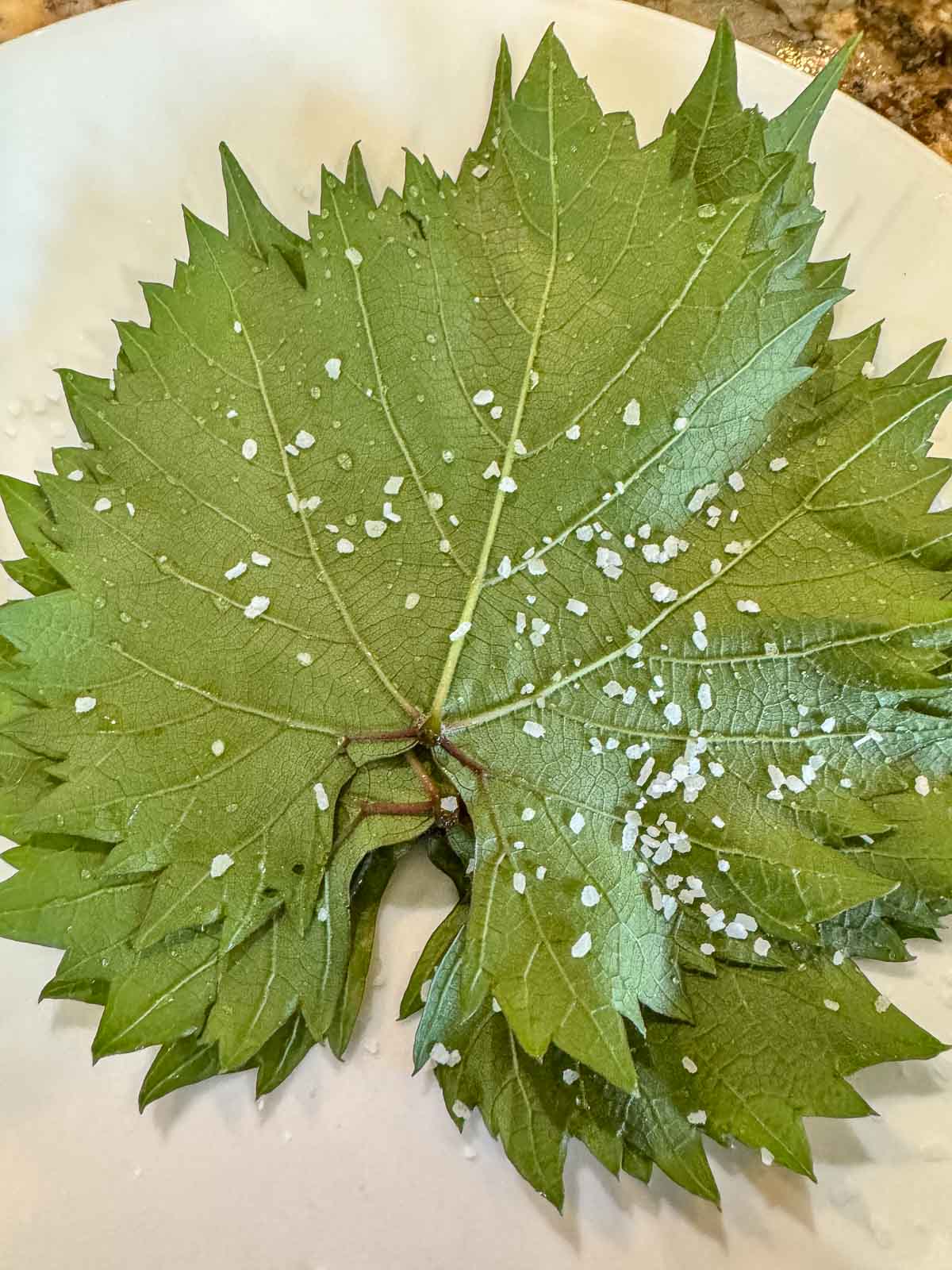

Step 3: Sprinkle some salt into a sterilized quart-sized mason jar then stand 5 rolls upward into the jar, then sprinkle with additional salt.

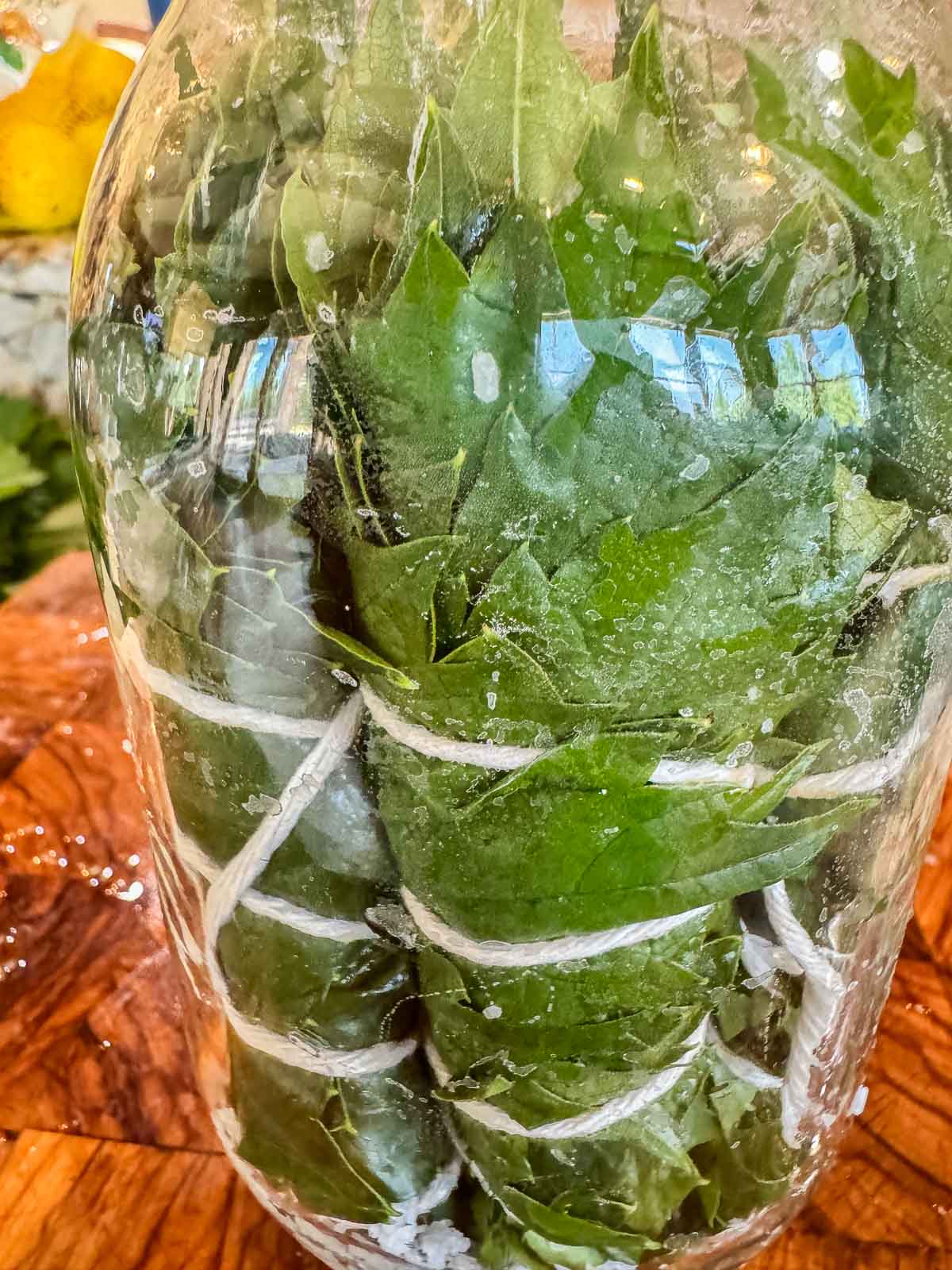
Pro Tip: If possible, use wide-mouthed mason jars, they're much easier to fill.
Step 4: Salt and roll the remaining 10 large leaves into a bundle and fit on top, covering the other leaves. Sprinkle with more salt, then seal the jar.
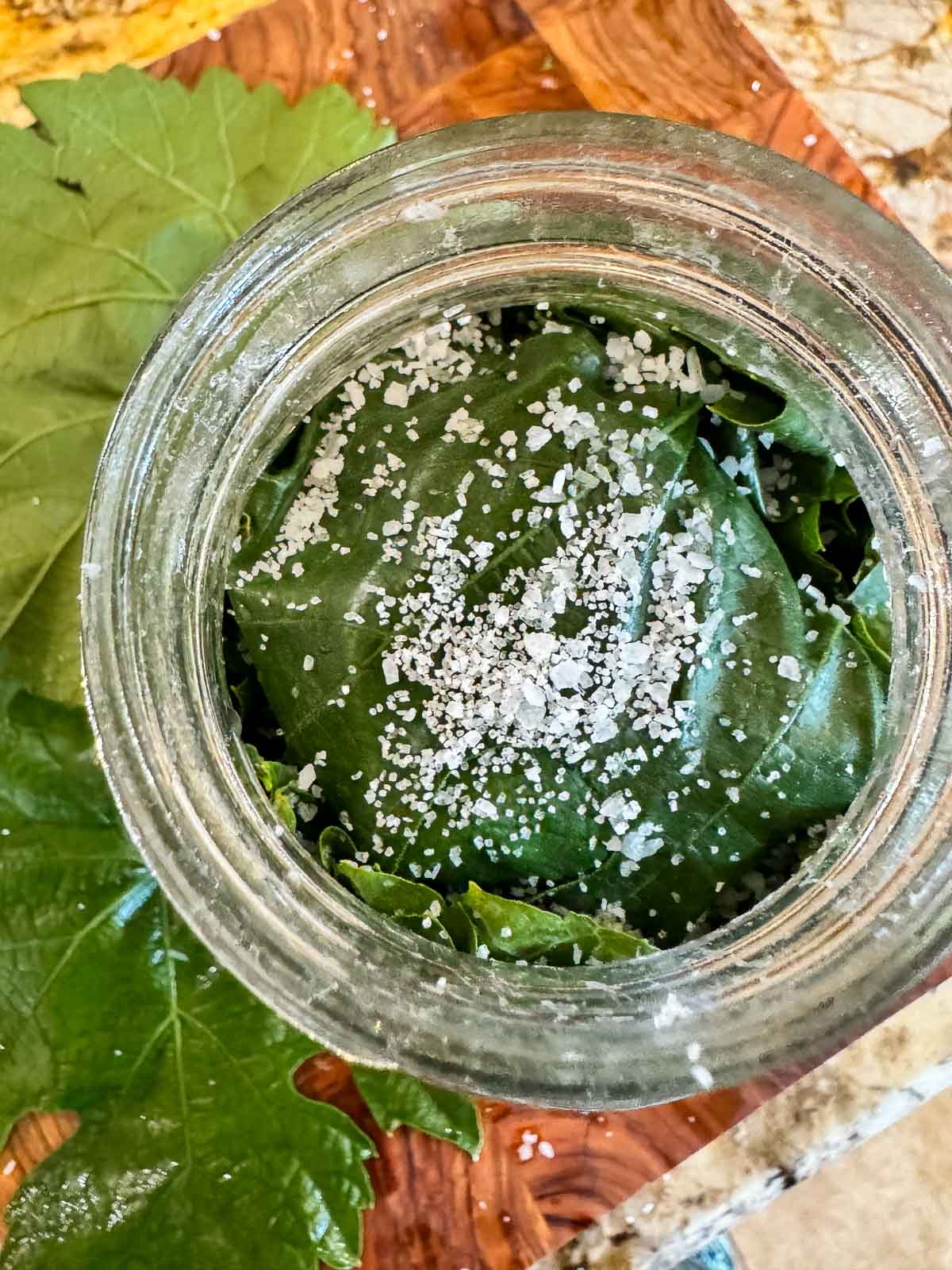

🫙 How to Store Pickled Grape Leaves
Store pickled grape leaves in a cool, dark location until the next time you're in the mood for dolma! They will keep for years, with no refrigeration necessary!
🍽 How to Use Preserved Grape Leaves
To use the grape leaves in your favorite recipe, you'll want to rinse the salt off and quickly blanch the leaves using the process described in step 3 of the first steps above.
🤷🏻♀️ FAQs
There are a few ways to preserve fresh grape leaves. One way is to salt the leaves and roll them into groups of ten, then place them in a sterilized jar, and sprinkle with additional salt.
The other way to preserve grape leaves is to blanch and roll them first. The rolls can then be added to a sterilized mason jar, and covered with boiling water, salt, and a tiny bit of citric acid.
Grape leaves can be used to make Dolma (also known as Dolmathes and Dolmadakia. Sometimes, the leaves are chopped and mixed with pilaf to make deconstructed dolma.
Yes, grape leaves can be frozen. You can freeze them freshly picked or blanch them first. The leaves can be piled flat and stored in a ziplock bag. Alternatively, they can be rolled in groups of 10 after being blanched and stored in quart-sized ziplock bags.
👩🏼🍳 Pro Tips
- The preserved leaves stored in water should last approximately 6 months, while the leaves preserved in salt should last a year or more.
- The leaves can be used immediately after being blanched to make Middle Eastern dolma or dolmadakia.
- Be sure to rinse leaves thoroughly before using them in your favorite recipe.
- Instead of citric acid, fresh lemon juice can be used.
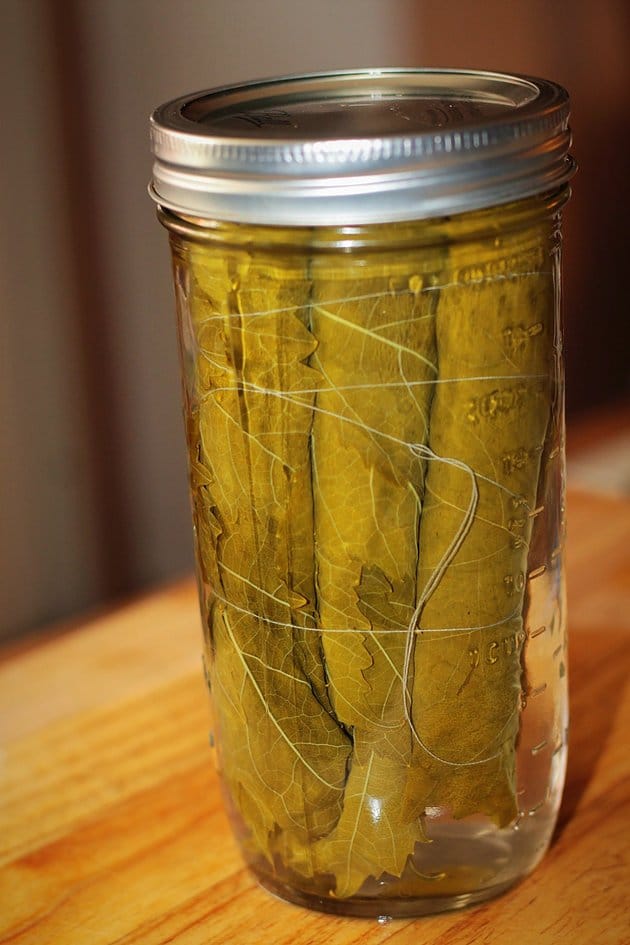
🥒 Related Recipes
Did you make this recipe?
📖 Recipe
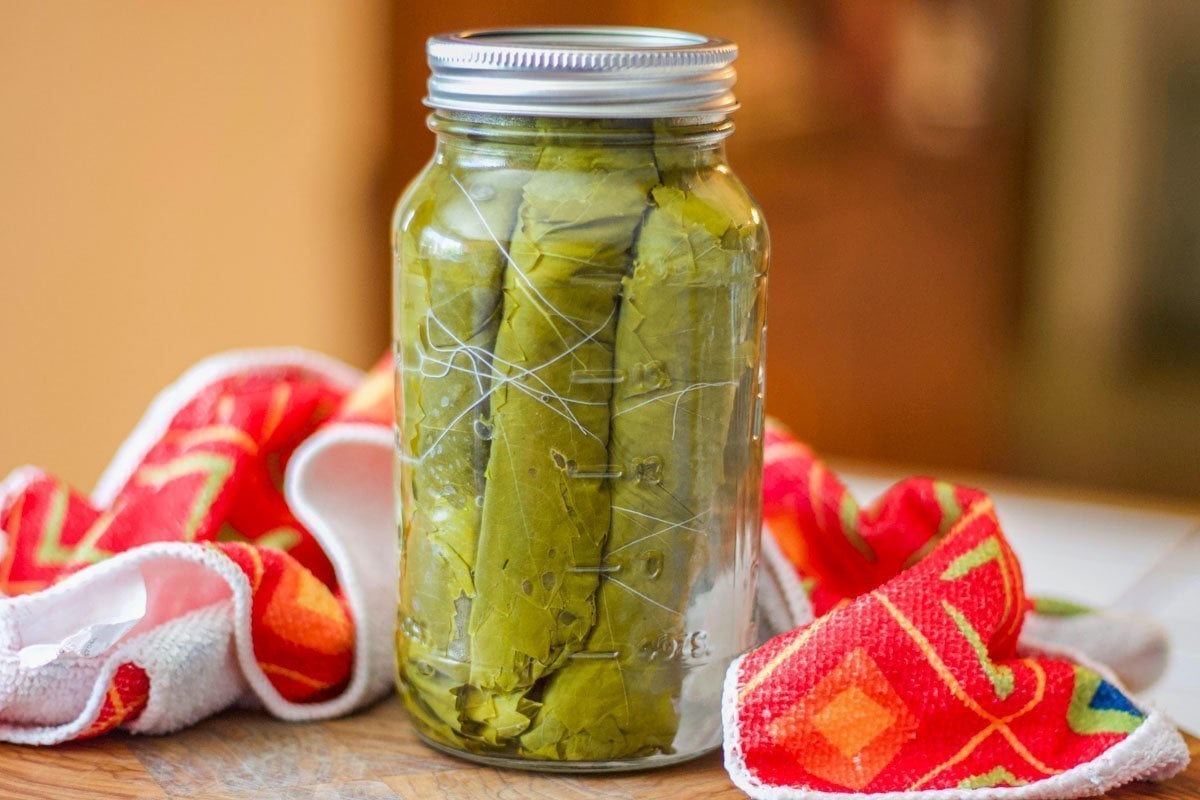
How to Pick and Pickle Grape Leaves
Ingredients
Equipment
Method
- Wash the leaves thoroughly, paying special attention to the back of the leaves, where bugs like to hang out and party!
- Next, put the leaves in piles of ten, making sure all the leaves are facing the same direction. This will make things easier when it comes time to stuff them.
- Boil approximately 8 cups of water, then simmer on low. Using tongs, gently place one pile of leaves in the water for 30 seconds, then carefully flip the entire pile and immerse for an additional 30 seconds.
- After blanching the leaves, drape over the side of a bowl and continue with the remaining piles.
- Once the water has drained out of the leaves, roll each pile into a cigar-shaped roll.
- Tie each pile with string. This will help keep them from unrolling when you place them in the jar.
- Boil three cups of water and stir in the salt and citric acid until completely dissolved. Stand the rolled leaves in a sterilized jar and pour the salted water over them, leaving ¼" headspace. Tighten the lid and process in boiling water for 10 minutes.
- Store the bottle in a cool, dark location until the next time you're in the mood for dolma!
- See post for an easier pickling method using only salt!
Nutrition
Video
Notes
- Depending on the leaves you are using, sometimes it takes a little longer for them to become pliable. The best way to tell when they're ready is when the color changes from bright green to a dull, olive color.
- If possible, use wide-mouthed mason jars, they're much easier to fill.
- The preserved leaves stored in water should last approximately 6 months, while the leaves preserved in salt should last a year or more.
- The leaves can be used immediately after being blanched to make Middle Eastern Dolma or dolmadakia (Greek dolma).
- Be sure to rinse leaves thoroughly before using them in your favorite recipe.
- Instead of citric acid, fresh lemon juice can be used.


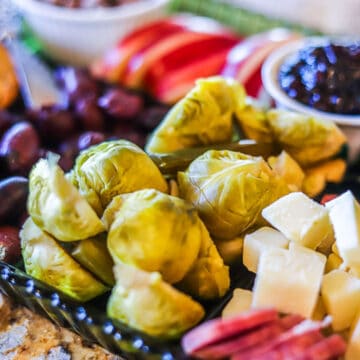
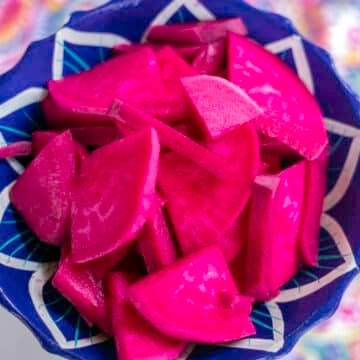
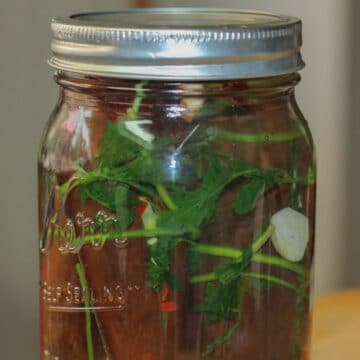

Sireah says
Please show us the type of grape so we can plant the right grapevine. Thank you for sharing all these techniques!
Hilda Sterner says
Hi Sireah, Thanks for your comment. There isn't one grapevine that I recommend over another. I've had various varieties that I've used over the years. The main thing to keep in mind is the shape of the leaves, which you'll be able to see when you are purchasing the grapevine. If you follow the tips in this post, you can't go wrong!
Rita says
Hi, Can you please let me know what type of grape variety you have? Would the Thompson grape work? thanks
Hilda Sterner says
Hi Rita, it's not really about the variety but the shape and texture of the leaves. I don't have the common variety, mine are various wine grapes. What do your leaves look like?
Rita says
Hi Hilda,
I'm in the process of buying a grape vine and was curious if one variety worked better than others. thanks
Hilda Sterner says
I would just inspect the leaves and make sure they're not too thick and again, make sure the shape falls in with the recommendations in the post. Good luck!
Michael Dietz says
When I make dill pickles, I use about the same amount of salt, and no acid. The bacteria on the cukes, which I imagine are also on the grape leaves, works with the salt, and cukes, and creates acid for the pickles (no citric acid nor vinegar, and no processing) to make wonderful pickles. My guess is that there's no need for the processing. I just can't see the old Greek ladies bothering with it.
Hilda Sterner says
Hi Michael, I can see what you are saying. Since writing this post, I've actually started preserving the leaves by sprinkling them with salt and adding them to sterilized jars, without any liquid. I've been meaning to update this post with that method as well!
marcia cooley says
this is the best of directions....splattered in with good
humour how can one go wrong?! Thank you for the
clarity. Appreciated. hugs from a Mediterranean lover
of foods.
Franci says
Great information Thanks
Hilda Sterner says
Thank you!
Claire says
Hi, wondering if I can use leaves from my ornamental grapevine? Thanks
Hilda Sterner says
Hi Claire,
I would think yes, but I can't say for sure. Maybe ask your local nursery, or try one of those plant identification apps. Sorry I couldn't be of more help.
Claire says
Thanks for getting back to me, will do. 😊
Philip says
For years, I have been cooking with wild grapes leaves that my wife and I collect. It took us a bit of trial and error to figure how to use the fresh leaves. Most recipes assume that we will be using the store bought canned leaves. Thanks for taking the time to describe the steps for using and preserving fresh leaves.
One thing that I have found is that there are "different" kinds of grape leaves. We grow several varieties of seedless grapes in our garden. Those grapes have a fuzzy tough texture. The "wild" grapes that grow along our fence lines are smooth and tender. For this reason I only use the wild leaves for cooking.
Robert Fusco says
I love your recipes. I have 10 grape plants and so many leaves, I am looking for ways to prepare them as fresh veggies at mealtimes.
Thank you, Robert
Catherine says
Hello! Would you kindly provide the amount of salt and citric acid (or ideally, fresh lemon juice)? How long do they need to stay in brine before using? How long can they stay in brine without canning them? Many thanks in advance - your videos are splendid!
Hilda Sterner says
Sorry about that, somehow the recipe card on the bottom of the page got deleted. I just added it again and it should answer all your questions. But basically, you can use the leaves as soon as they are blanched, they don't need to be brined to be used. We just brine the leaves to preserve them to use at a later date.